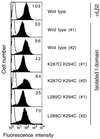An isolated, surface-expressed I domain of the integrin alphaLbeta2 is sufficient for strong adhesive function when locked in the open conformation with a disulfide bond
- PMID: 11226249
- PMCID: PMC30148
- DOI: 10.1073/pnas.041606398
An isolated, surface-expressed I domain of the integrin alphaLbeta2 is sufficient for strong adhesive function when locked in the open conformation with a disulfide bond
Abstract
We introduced disulfide bonds to lock the integrin alphaLbeta2 I domain in predicted open, ligand binding or closed, nonbinding conformations. Transfectants expressing alphaLbeta2 heterodimers containing locked-open but not locked-closed or wild-type I domains constitutively adhered to intercellular adhesion molecule-1 (ICAM-1) substrates. Locking the I domain closed abolished constitutive and activatable adhesion. The isolated locked-open I domain bound as well as the activated alphaLbeta2 heterodimer, and binding was abolished by reduction of the disulfide. Lovastatin, which binds under the conformationally mobile C-terminal alpha-helix of the I domain, inhibited binding to ICAM-1 by alphaLbeta2 with wild-type, but not locked-open I domains. These data establish the importance of conformational change in the alphaL I domain for adhesive function and show that this domain is sufficient for full adhesive activity.
Figures






References
-
- Larson R S, Springer T A. Immunol Rev. 1990;114:181–217. - PubMed
-
- Springer T A. Cell. 1994;76:301–314. - PubMed
-
- Gahmberg C G, Tolvanen M, Kotovuori P. Eur J Biochem. 1997;245:215–232. - PubMed
-
- Diamond M S, Springer T A. Curr Biol. 1994;4:506–517. - PubMed
-
- Humphries M J. Biochem Soc Trans. 2000;28:311–339. - PubMed
Publication types
MeSH terms
Substances
Grants and funding
LinkOut - more resources
Full Text Sources
Other Literature Sources
Miscellaneous

